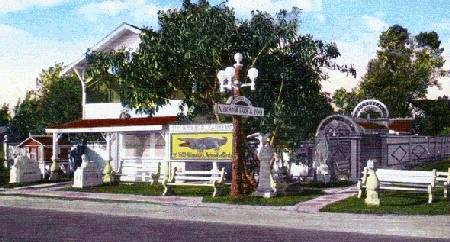
 |
The Saint Petersburg Alligator Farm |
|
Home Attractions List Books Poster Gallery Timeline
|

No trip to Florida in the first half of the twentieth century was complete without seeing the fabled alligator. The trouble is, as motels and sea shell shops moved in, the gators moved out. Civilization and hunting saw to that. You had to actually get out of the car and head for the wilds to be sure of seeing one in its natural state. Some gas stations and fruit stands were known to acquire a small alligator or two to help snag the passing tourist (A few such places exist even today). It was the era when baby alligators (or similar looking lizards masquerading as alligators) were actually sold to any passing fool as pets. What they thought they'd do with a few hundred pounds of hissing, biting crocodilian once it grew up is anyone's guess. Fortunately for the consumer, most of them couldn't take the northern winters and died young. (There is no truth, however, to the oft repeated tale that these alligators wound up living in the New York City Sewer System. Cold sewer water is not the ideal gator growth medium).
You could see a big, writhing pit of 'em at any of a number of Alligator Farms that sprung up along the tourist routes. Some of these "farms" even did make their money primarily by selling the hides and meat, with the tourist dollars just gator gravy on top. Others were pure tourist traps. Saint Petersburg, as befits what was once Florida's top tourist destination, had this nicely outfitted example at 36th Avenue South and 6th Street South. For a mere 35 cents (1939 price) you could view their collection of 1,500 alligators and visit a small zoo of Florida animals and reptiles. Today, of course, the tourists have found other destinations, St. Petersburg has grown up -- and the alligators have moved on.
|
|
Return To Florida's Lost Tourist Attractions, a site celebrating the now defunct tourist attractions of the Sunshine State. The attraction profiled on this page no longer exists.
This site Copyright (c) 1997-2011 by Robert H. Brown Postcard image courtesy Florida State Archives Photographic Collection.
|